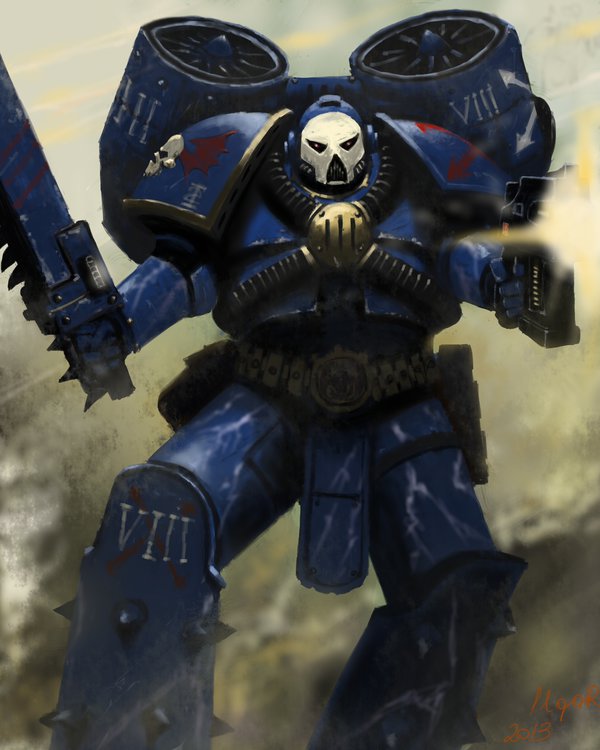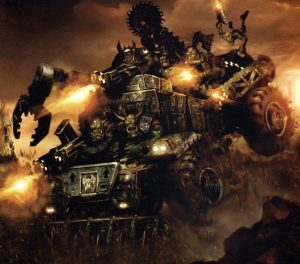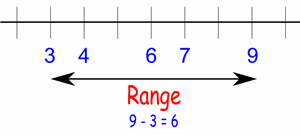Hello everyone, Steven Pampreen here! You may have heard of me as the guy who keeps bringing assault Orks to a gun fight. This article will cover many of the tactics used during the assault phase, and show you how to make it work for you. Be sure to check the Tactics Corner for more great articles.
While playing my Orks at Nova, I noticed a common thread among my opponents. Do to the overwhelming popularity of shooting — even with NOVAs unique terrain and missions — many of my opponents were unfamiliar with the assault phase. As someone who has decided that he likes torturing himself by playing a pure assault list, I’ve become very intimately involved with the assault phase. So I’m going to talk about the most common misconceptions I ran into.
Unit by Unit activation
You activate each unit one at a time, then you move onto the next unit.
This is a basic of the assault phase, and has a lot of repercussions. The most common one I found was someone charging a blob of orks already in assault. The charging unit kills a couple Orks. Orks are pretty easy to kill, so I expect to lose a few. I pull these boys from the unit the boys were already fighting — not from the unit that just charged.
Now when it’s the unit who started the fight phase in bases turn to fight, they’re no longer within an inch and they didn’t charge so they can’t activate. By pulling the boys close to the first unit, I’ve kept his unit from attacking mine.
Let’s say my boys were engaged with Cawl previously. I have prevented that Cawl from clobbering my boys with 2d6 + 5 attacks in that assault phase. Sure, he can charge me next turn or shoot at me but I just stopped him from doing any of that for a whole turn. If this happens at the end of a game, it can be the difference between a win or a loss.
Who Can Activate
You can activate any unit that charged or is within an inch of an enemy unit.
A Big Mek and a boys squad charged a Scout Squad, the boys swing wipe out the Scouts. Now I can activate the Big Mek to fight. He piles in 3 towards the nearest enemy, then swings (at nothing), then consolidates 3 towards the nearest enemy. This means that even if there is nothing left to swing at, you can gain 6” of extra movement by charging a unit.
Being In Range
A model within an inch of a model within an inch can swing.
GW meant for only 2 ranks to fight. However, they did not consult their freedom unit to metric conversion table! A 2.5 centimeter base is less than an inch(2.54 centimeters). This means that the second row is within an inch and the fourth row is within an inch of the second row. So basically, 4 rows of Orks can fight if they’re all base to base. Applies to any horde army on 25mm bases.
Falling Back
Falling back models following normal movement rules.
Many people think that falling back works like 7th edition Hit and Run where you can move through models. That’s not the case unless they have fly. The obvious repercussion being, if you can’t move through models and there is nowhere to go, then you’re stuck.
So on a round base this means three points of contact where you cannot find 180 degrees without a model basing you. It doesn’t matter if you can “scooch” him out. If your opponent can find a single model in the unit which meet those 2 conditions the unit is trapped. This means that it’s shockingly easy to trap a model.
This gets even better if the charging models have the ‘fly’ ability. They can charge all around the enemy unit. I cannot tell you how many times I’ve trapped large models such as Imperial Knights, with Plague Drones.
Charge Movements
You move a model from the unit within 1 inch, otherwise move wherever.
You just have to get a model to swing (within an inch) and then the rest of your unit can go anywhere (outside an inch of an enemy unit you didn’t declare). This leaves you a heady amount of flexibility on where to move, use it wisely! This is a great place to zone out deep strikers or grab objectives with extra movement. However, don’t confuse the charge phase with pile in and consolidate.
Pile in and Consolidate
Move towards the nearest enemy Model.
Importantly, this movement can go within an inch of any enemy unit. At the beginning of the edition, I suffered my own misconception and spidered out ending nearer ANY enemy unit. You have to go closer to the nearest enemy model. However, you still have a lot of latitude with how to move your models.
“Towards a Model” movement
Towards means you end closer, that’s it.
You must end closer. Which means any distance closer in any direction you wish. So my Stormboyz moved from a hairsbreadth away to base to base but on the opposite side? That’s legal, I’m closer. Also with this rule and Xeno’s paradox means you can perpetually move closer and never be base to base. I think a rule about always ending at least a half inch closer would fix a lot of the worst assault shenanigans. However, until “Double Quad” stops being an acceptable weapon description I’ll keep doing what I have to do. Plus these tactics add a lot of depth to the game.
Heroic Intervention
End of the charge phase pile in towards the nearest enemy model.
Heroic Intervention means that if a character is within 3 inches of an enemy unit at the end of the charge phase they can “Heroically Intervene”, basically a free pile in movement. They have to be within 3 inches of the ENEMY unit not the unit that was charged. This also doesn’t circumvent the rules for fight phase activation. If you are within 3 inches of an enemy unit, you try to pile in but you’re trapped by your own unit and you can’t get within an inch. Unless that situation changes, still no heroics for you.
Treat heroic intervention as a free 3 inch pile in at the end of the charge phase if your opponent was kind enough to go within 3 inches. Once you’re in the fight phase, the intervention is over and treat the character as if that’s where they were standing when the assault was declared.
Ineligible Receiver Downfield
You must declare units being charged during charge phase if you want to attack them in the fight phase.
People are becoming more and more accustomed to this but it’s still worth mentioning in any article on assault mechanics. You can’t attack units on the turn you charged that you didn’t declare a charge against. As a savvy assault player, you can use this to your advantage, by surrounding a model you cannot actually attack due to not declaring them as a unit you were charging. In turn locking yourself in combat during your opponents shooting phase.
So much extra movement
You get more movement in the assault phase than most units get in the movement phase.
We used to call the extra movement from charging slingshotting, but now its basically galactic traveling. You get the 2d6 charge move, and two 3 inch movements towards the closest enemy models. All these movements help you get up the table and also help control the board.
Also some units get to move further such as Berzerkers and Hormagaunts.
How did your Stormboys get there? you must have cheated!
Only against Pat McAneeny
Well hopefully this article helps some of you with the assault phase and clears up some of the confusion behind it. Once you master the assault phase it will help you to master eighth edition 40k. Let me know what kind of tricks you like to pull off during the assault phase in the comments.
And remember, Frontline Gaming sells gaming products at a discount, every day in their webcart!














Great article.
Knowing these rules inside out helps some shooty armies too, such as Tau running crisis suits and commanders.
I’ve definitely seen lots of times my opponents did the wrong thing because they weren’t aware of how assault works. Mainly I wrote the article because I was tired of people getting salty.
Nicely written. A ton of players at our local shops have trouble taking advantage these tactics. They lose great opportunities because they don’t think of this stuff. As an Aos played who plays 8th too, I feel like I’ve had a huge advantage because of experience with the system. This type of article could help a lot of players.
I would like to see how the 25mm base is handled in metric countries, do the rules state within 25mm or do they use the inch language? I think it is conversion error they got as closer as possible and did not want to write if you are within .99 inches and rounded to one.
Since 8th, rules come in inches in all countries, but before, the game was mostly metric in metric countries , but existed a convoluted conversion system called movement units for when you had to move a random distance in which odd numbers were rounded down an even numbers rounded up, like this:
1” (1mu)=2 cm
2” (2mu)= 5 cm
3” = 7 cm
4”= 10 cm
And so on…
Of course, everyone just used inches…
(Funny thing was that before random charge was a thing, hence spawning the “movement unit”, random distances were in metric units too, so warp spiders would move 5d6 cm in their jump, but you would still lose a member of the squad on a double. Jumping in the warp was a lot more dangerous if your spiders spoke spanish…
As someone pointed put. The .99 inches vs 2.54 or 2.5 mm doesn’t matter as much because you can still fit in with a honey comb pattern. However I have all my orks on trays so it’s certainly much more convenient to leave them on the tray.
I really hate this whole concept of “oh a 25 mm is .0001 less than an inch so I get to fight with 4 ranks”. And as a TO I don’t allow it. It is very clear the intent is to allow for two tanks and with the advent of the 32mm base as “standard” in most GW kits anymore, which would prevent this entire concept, I rule it as only first two ranks can fight regardless of base size. Which is how it is supposed to be.
That is a reasonable ruling.
Is it in the rules pack for the tournament? Because it would be frustrating to first hear about it in a table ruling.
If you stagger the bases, you can easily get 25mm, and even 32mm, bases clearly within distance to fight in 4 “ranks”, without having to resort to conversion rate shenanigans.
Ah, the good old RAI vs RAW. It’s very annoying to hear a TO is opting for RAI since what is ‘intended’ is almost always someone’s arbitrary opinion. Good to know you are ruling based on your opinion and not how the rules are written. While yer at it you should just add wounds to space marines too. I mean all the fluff and fiction books out there describe marines as unstoppable creatures of war. Obviously, the rules writers made a typo by only giving them 1 wound since they certainly intended them to be way more buff they the rules say they are.
*rolls eyes* I’ll avoid your tourneys for sure but you may want to publish whatever other rules you happenstance decided to ignore for the poor players who do decide to attend.
Aside from my comment above about base sizes, the article was really well done. Lots of good info people can gain from learning how the assault phase works.
Excellent write-up. There is a ton of depth in the Fight Phase, and it takes a while to really get the hang of it all.
Maybe add a bit to the section on locking the Knight down with Plague Drones noting that it works because the Super Heavy Walker Rule only lets is step over Infantry Models during a Fall Back, so it needs to be something bigger like Plague Drones or Deff Koptaz.
Note also that even 32mm based Models can actually get 4 “ranks” in combat if you stagger the bases so they’re in a hexagonal pack instead of a rectangular one. 40mm need to leave some room between each Model in a given “rank” for the next to squeeze in a bit closer, but they can still pretty easily get 3.
With careful positioning yes it is definitely possible.
True but you would be hard pressed to get 30 models fighting that way. where as with the 1″ shenanigans you can get all 30 within a 8″ width.
Hang on a second. In your Unit by Unit Activation you said, “Now when it’s the unit who started the fight phase in bases turn to fight, they’re no longer within an inch and they didn’t charge so they can’t activate. By pulling the boys close to the first unit, I’ve kept his unit from attacking mine.”
Then in the next section Who Can Activate, you said, “A big mek and a boys squad charged a scout squad, the boys swing wipe out the scouts. Now I can activate the big mek to fight. He piles in 3 towards the nearest enemy, then swings (at nothing), then consolidates 3 towards the nearest enemy.”
Isn’t this a contradiction?
The difference is the charging units. In the first example. The unit pulled out of the fight didn’t charge. In the second example both units charged. So again, go unit by unit, first activate all the charging units THEN units who are within an inch. I hope that helps! I may make a video at some point to show these concepts.
Nice article! The Assault Phase sure has a lot more tactics in it than before.
One that you didn’t mention is pulling your punches to ensure you get to stay locked in combat. For example, my Ultramarine Tacticals will often charge even if they suck in combat simply to avoid getting shot, when possible. To avoid having the enemy fall back in his turn, you need to lock him by surrounding at least one of his models on 3 sides. This can be difficult to do when fighting a canny opponent as he can remove the models you have surrounded thusly as casualties. To avoid this, what you can do is have only one Tactical Marine get within 1 inch of the enemy unit and making sure the other guys are more than 1 inch away from both the other enemy models and the Tactical Marine engaged. A single Marine has less than 30% change of killing a single Guardsman, so your chances of successfully locking the enemy are pretty good.
But if you do that (i.e. get only one marine who can fight), how do you then get 3 marines into base contact with a model to locket in?
You move them into contact during consolidation.
Nice one, Desc
o7
Sorry, I’m not trying to be difficult, but you only get 3″ consolidation. If you’re keeping everything bar one model more than 1″ away, from that one model, won’t it be virtually impossible to block in the model your attacking, with just a 3″ consolidation? I need to go and dig out some models and try it, I just can’t picture it.
I’ll break it down a bit more:
1) After your charge move + pile in, your lone attack should be 0.0000001 inch away from the model he is going to lock (if he’s not unfortunate enough to kill him) and the rest of the models are 1.0000001 away from him (so the models are in effect 2.000002 inches away from the enemy model you want to lock).
2) After you’re done swinging, and if you hopefully didn’t kill the model you wanted to lock, the model that was swinging uses his 3 inch consolidate to move behind the enemy model and into base contact (which is legal, as he is ending his move closer to him than he started) and the 2 next closest guys move in to base contact in such a way that there’s no room for the enemy model to escape.
Ahh…that makes more sense. I hadn’t thought about moving the one that’s 0.00001″ away to the rear of the model I wanted to lock.
Hi Desc,
You’re right! locking brims and guardsman is probably the most common tactic I use against good players. However, this article was meant to be a “common misconceptions” style article rather than a true tactics article. It seems to have received some positive reaction so I may be motivated to write a second one focusing entirely on proper movement. I think a video would be the best medium so keep an eye out for it!
Oh it wasn’t a criticism – I thought maybe you didn’t know/hadn’t thought of talking about it, hence why I mentioned it. Keep up the good work!
Awesome article. I deduced alot of the shinanigans you discussed from other articles and experience as an ork and demon player, but you did drop some good gems in there 🙂 The 25mm base cheesiness is classic though 😛 rules lawyering for the win 😛
Im new to 40k and during a game the other day something came up that we weren’t sure how to deal with. During the combat phase if your opponent kills all models within an inch but there are more of the unit left further away and he has attacks left can he attack the rest of the enemy unit even if its further away than an inch?
I’m also wondering about this. My assumption is that if a unit is activated (through having charged or by being within 1″) then they can resolve all their attacks against the unit(s) they charged, regardless of which enemy models are removed as casualties. One would then assume their consolidation move is used to get back within an inch of any models that remain alive in the unit that was being attacked.
You declare all the Attacks the Unit is making in Step 3 and 4 of the Fight Sequence. Then you resolve them all in Step 5. Unless the target Unit has been completely wiped out, you get to make all the Attacks that you declared. The resolution may be split up a bit because of different Weapons or whatever, but it all still gets resolved as long as the target is still there.